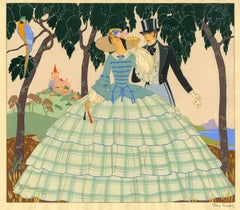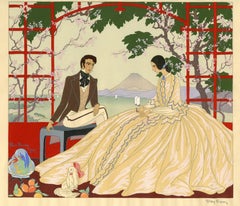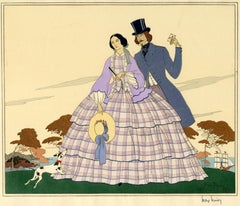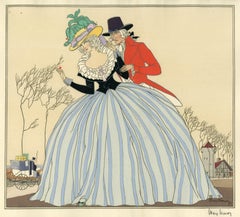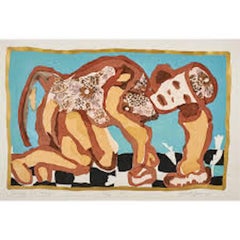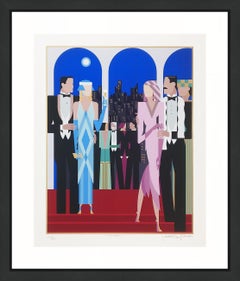Victor Max Ninon Art
to
4
4
4
4
En Espagne
By Victor Max Ninon
Located in Fairlawn, OH
En Espagne
Pochoir (silk screen) printed in colors
Signed by the artist in pencil lower right
The artist won a gold medal in Paris in 1925 for his pochoirs
Condition: Excellent
Image...
Category
1920s Art Deco Victor Max Ninon Art
Materials
Screen
Au Japon
By Victor Max Ninon
Located in Fairlawn, OH
Au Japon
Pochoir (Stencil Print), 1925
Signed by the artist in pencil lower right (see photo)
Signed in the image lower left (see photo)
Stamped verso: Made in France
Note: The artis...
Category
1920s Art Deco Victor Max Ninon Art
Materials
Screen
Coquette
By Victor Max Ninon
Located in Fairlawn, OH
Coquette
Pochoir (silk screen) printed in colors, c. 1923-1925
Signed by the artist in pencil lower right; numbered in ink on the image, (see photo)
Edition: 250 (100/250) in pencil in image (see photo)
Image size: 10-1/2 x 12-3/4"
The artist won a gold medal in Paris in 1925 for his porchoirs
Victor Max Ninon (Vittorio Accornero de Testa, Italian, 1896-1982)
Biography
Vittorio Accornero de Testa was born in Casale Monferrato in 1896. He completed his first studies at the "Leardi" institute, but was forced to interrupt them due to the war events of the First World War . At 19 he was second lieutenant of the Alpine troops and in 1916 he took one of the first pilot's licenses. During the war he knows the bitterness of shooting down in air combat (for which he is decorated), but also the good fortune to stay alive, albeit with a disability. His art blossomed in the postwar period, first signing his works simply Ninon and then, probably at the suggestion of a French publisher, under the pseudonym of "Victor Max Ninon" (Victor and Max indicate strength and masculinity, Ninon boyhood) .In 1919 and 1924 he made illustrations for theGiornalino della Domenica , also together with his first wife Edina Altara , for Ardita and La Lettura . In 1923 he won the cover competition organized by the magazine El Hogar of Buenos Aires and in 1925 with his pochoirs he imposed himself in Paris at the international exhibition of modern decorative and industrial arts , obtaining a gold medal. In the same year he made two covers for the US magazine The Smart Set . In the 1920s he made numerous series of art deco style postcards for the Milanese publishing house Degami . On June 4, 1929, aGenoa embarks on the Conte Grande together with his wife Edina Altara , for New York . The two stayed in the American metropolis for a few months: in this period Accornero worked on the creation of theatrical sets and created some covers for Country Life magazine . Accornero gets awards and prizes, but the great economic crisis of the time and the nostalgia for Italy convince the two to return to their homeland, where they resume their activity as illustrators.
In 1934 Accornero moved to Milan, separated amicably from his wife and continued to dedicate himself to the illustration of children's books, abandoning the pseudonym Victor Max Ninon. It illustrates about 60 books, from the fables of Andersen , Perrault and Grimm , to the tales of Poe , as well as the famous Pinocchio and Cuore published by Mondadori, Mursia, Hoepli, Martello. Several books illustrated by Accornero have been published in French, Spanish, German and English. In addition to the periodicals already mentioned, he collaborates on the first edition of the Encyclopedia of Boys , Mondadori, and with the Italian magazines Lidel , Il Secolo XX, The Italian Illustration , Fantasies of Italy , The Woman , Cordelia , For You Lady , Grace , Metropolis , La Domenica del Corriere , The Corriere dei Piccoli .
In 1936 enters the world of cinema, creating sets and costumes for Wedding Vagabonde of Guido Brignone and The White Squadron of Augustus Genina . From 1935 to 1950 he also devoted himself to the theater, taking care of sets and costumes for numerous operettas, ballets and performances at the Scala in Milan and for the Milanese theaters Manzoni, Lirico and Olympia. Stages Marcello di Giordano, Nina pazza d'amore by Paisiello, I cantori di Nurimberga by Wagner, La Bohème by Puccini and other works. For this activity he is also cited in the Theater encyclopedia.
In the 1940s and 1950s he wrote and illustrated six books for children for Mondadori: Tomaso (1944), Giacomino (1949), Tomaso Cacciatore (1950), Zio Stefano (1950), In Campagna che delizia! (1953), Tomaso, dear Tomaso (1955). His illustrations of Perrault's Tales published in those years by Hoepli are famous.
His art in the fifties evolves towards hyperrealism . There are many personal exhibitions in Italy and abroad, including those at the Gallerie Gussoni (1959) and Bolzani (1963 and 1966) in Milan and Walcheturm (1962) in Zurich. Eminent critics praise his work, from Orio Vergani to Enrico Piceni, from Reto Roedel to De Chirico himself. On the Domenica del Corriere , the journalist, writer and painter Dino Buzzati...
Category
1920s Art Deco Victor Max Ninon Art
Materials
Stencil
Robe Grise
By Victor Max Ninon
Located in Fairlawn, OH
Robe Grise
Pochoir (silk screen) printed in colors, 1923
Signed by the artist in pencil lower right (see photo)
The artist won a gold medal in Paris in 1925 for his pochoirs
Condition: Two spots in the upper left corner associated with the printing.
Victor Max Ninon (Vittorio Accornero de Testa, Italian, 1896-1982)
Biography
Vittorio Accornero de Testa was born in Casale Monferrato in 1896. He completed his first studies at the "Leardi" institute, but was forced to interrupt them due to the war events of the First World War . At 19 he was second lieutenant of the Alpine troops and in 1916 he took one of the first pilot's licenses. During the war he knows the bitterness of shooting down in air combat (for which he is decorated), but also the good fortune to stay alive, albeit with a disability. His art blossomed in the postwar period, first signing his works simply Ninon and then, probably at the suggestion of a French publisher, under the pseudonym of "Victor Max Ninon" (Victor and Max indicate strength and masculinity, Ninon boyhood) .In 1919 and 1924 he made illustrations for theGiornalino della Domenica , also together with his first wife Edina Altara , for Ardita and La Lettura . In 1923 he won the cover competition organized by the magazine El Hogar of Buenos Aires and in 1925 with his pochoirs he imposed himself in Paris at the international exhibition of modern decorative and industrial arts , obtaining a gold medal. In the same year he made two covers for the US magazine The Smart Set . In the 1920s he made numerous series of art deco style postcards for the Milanese publishing house Degami . On June 4, 1929, aGenoa embarks on the Conte Grande together with his wife Edina Altara , for New York . The two stayed in the American metropolis for a few months: in this period Accornero worked on the creation of theatrical sets and created some covers for Country Life magazine . Accornero gets awards and prizes, but the great economic crisis of the time and the nostalgia for Italy convince the two to return to their homeland, where they resume their activity as illustrators.
In 1934 Accornero moved to Milan, separated amicably from his wife and continued to dedicate himself to the illustration of children's books, abandoning the pseudonym Victor Max Ninon. It illustrates about 60 books, from the fables of Andersen , Perrault and Grimm , to the tales of Poe , as well as the famous Pinocchio and Cuore published by Mondadori, Mursia, Hoepli, Martello. Several books illustrated by Accornero have been published in French, Spanish, German and English. In addition to the periodicals already mentioned, he collaborates on the first edition of the Encyclopedia of Boys , Mondadori, and with the Italian magazines Lidel , Il Secolo XX, The Italian Illustration , Fantasies of Italy , The Woman , Cordelia , For You Lady , Grace , Metropolis , La Domenica del Corriere , The Corriere dei Piccoli .
In 1936 enters the world of cinema, creating sets and costumes for Wedding Vagabonde of Guido Brignone and The White Squadron of Augustus Genina . From 1935 to 1950 he also devoted himself to the theater, taking care of sets and costumes for numerous operettas, ballets and performances at the Scala in Milan and for the Milanese theaters Manzoni, Lirico and Olympia. Stages Marcello di Giordano, Nina pazza d'amore by Paisiello, I cantori di Nurimberga by Wagner, La Bohème by Puccini and other works. For this activity he is also cited in the Theater encyclopedia.
In the 1940s and 1950s he wrote and illustrated six books for children for Mondadori: Tomaso (1944), Giacomino (1949), Tomaso Cacciatore (1950), Zio Stefano (1950), In Campagna che delizia! (1953), Tomaso, dear Tomaso (1955). His illustrations of Perrault's Tales published in those years by Hoepli are famous.
His art in the fifties evolves towards hyperrealism . There are many personal exhibitions in Italy and abroad, including those at the Gallerie Gussoni (1959) and Bolzani (1963 and 1966) in Milan and Walcheturm (1962) in Zurich. Eminent critics praise his work, from Orio Vergani to Enrico Piceni, from Reto Roedel to De Chirico himself. On the Domenica del Corriere , the journalist, writer and painter Dino...
Category
1920s Art Deco Victor Max Ninon Art
Materials
Stencil
Related Items
Bellhop
By Roberto Juarez
Located in New York, NY
Many places, many times intermingle in the work of Roberto Juarez. His life is so much a part of his work, that each new body of work introduces subjects, styles and motifs that seem...
Category
Late 20th Century Modern Victor Max Ninon Art
Materials
Stencil
FIVE ARCHES I
By Giancarlo Impiglia
Located in Aventura, FL
Screenprint in colors on paper. Hand signed, titled and numbered by the artist. Edition of 250. Image size 25 x 19.5 inches. Sheet size 35 x 27.5. Custom framed as pictured.
A...
Category
1980s Art Deco Victor Max Ninon Art
Materials
Paper, Screen
Still life with Blue Pitcher and Fruits - Lithograph and Stencil, 1950
By Fernand Léger
Located in Paris, IDF
Fernand LÉGER
Still life with Blue Pitcher and Fruits, c. 1950
Original lithograph and stencil (Jacomet workshop)
Printed signature in the plate
On paper 43 x 33 cm (c. 17 x 13 Inc...
Category
1950s Modern Victor Max Ninon Art
Materials
Lithograph, Stencil
The Dove and the Snake, 1933 - Original Lithograph
By Jacques Camus
Located in Paris, IDF
Jacques Camus
The Dove and the Snake, 1933
Original lithograph and stencil
Unsigned
On paper 39 x 29 cm (c. 15.3 x 11.4 inch)
INFORMATION : This lithograph is part of the "Idées" p...
Category
1930s Art Deco Victor Max Ninon Art
Materials
Lithograph, Stencil
Rare serigraph "The Grand Party" Giancarlo Impiglia
By Giancarlo Impiglia
Located in Bridgehampton, NY
"The Grand Party:" A rare hand-dated and signed serigraph by world-renowned Giancarlo Impiglia, whose value is bound only to increase.
Born in Rome, Impiglia moved to New York in th...
Category
2010s Art Deco Victor Max Ninon Art
Materials
Screen
Art Deco 1925 Signed Limited Edition Screen Print
By Michael Knigin
Located in Rochester Hills, MI
Art Deco 1925
1980
Silkscreen
Paper size 33½" × 21"inches
Signed in pencil and marked 234/300
Michael Knigin was born in 1942 in Brooklyn, NY. He attended and graduated from Tyler S...
Category
1980s Art Deco Victor Max Ninon Art
Materials
Screen
Au Lido - Pochoir by G. Barbier - 1920
By George Barbier
Located in Roma, IT
This pochoir belongs to the portfolio 'Le Bonheur du Jour', by George Barbier.
A very fine work of one of the most important and famous european illustrators of Art Deco, whose infl...
Category
1920s Art Deco Victor Max Ninon Art
Materials
Stencil
$2,010 Sale Price
30% Off
H 12.6 in W 17.72 in D 0.04 in
The Big Band, Art Deco Screenprint by Giancarlo Impiglia
By Giancarlo Impiglia
Located in Long Island City, NY
Giancarlo Impiglia, Italian/American (1940 - ) - The Big Band, Year: 1987, Medium: Screenprint, signed and numbered in pencil, Edition: 57/300, Size: 31 ...
Category
1980s Art Deco Victor Max Ninon Art
Materials
Screen
$2,800
H 42 in W 37.5 in
Her Secret Admirers, Framed Art Deco Screenprint by Erte
By Erté
Located in Long Island City, NY
Artist: Erte, Russian (1892 - 1989)
Title: Her Secret Admirers
Year: 1982
Medium: Screenprint, signed and numbered in pencil
Edition: 300
Image Size: 33 in. x 24 in. (83.82 cm x 60.9...
Category
1980s Art Deco Victor Max Ninon Art
Materials
Screen
L'apres-midi d'un Faune - Pochoir by G. Barbier - 1920
By George Barbier
Located in Roma, IT
This is one of the artworks in the portfolio 'Le Bonheur du Jour', by George Barbier.
A very fine work of one of the most important and famous european illustrators of Art Deco, who...
Category
1920s Art Deco Victor Max Ninon Art
Materials
Stencil
$2,010 Sale Price
30% Off
H 12.6 in W 17.72 in D 0.04 in
Copyright SADNESS (PINK) Screen print, acrylic & spray Street art Graffiti Urban
By Copyright
Located in Madrid, Madrid
Copyright - Sadness Screen - Pink
Date of creation: 2016
Medium: Silkscreen, acrylic and spray paint on paper
Edition: 25
Size: 50 x 35 cm
Condition: In perfect conditions and never ...
Category
2010s Street Art Victor Max Ninon Art
Materials
Spray Paint, Acrylic, Screen, Stencil
$388
H 19.69 in W 12.6 in
Cozy Corner
By Itzchak Tarkay
Located in San Francisco, CA
This artwork titled "Cozy Corner" c.1980 is an original color serigraph on paper by Israeli artist Itzchac Tarkay 1935-2012. It is hand signed, titled and inscribed E.A. in pencil b...
Category
Late 20th Century Art Deco Victor Max Ninon Art
Materials
Screen
Victor Max Ninon art for sale on 1stDibs.
Find a wide variety of authentic Victor Max Ninon art available for sale on 1stDibs. You can also browse by medium to find art by Victor Max Ninon in screen print, stencil and more. Much of the original work by this artist or collective was created during the 1920s and is mostly associated with the Art Deco style. Not every interior allows for large Victor Max Ninon art, so small editions measuring 13 inches across are available. Customers who are interested in this artist might also find the work of Umberto Brunelleschi, Georges Lepape, and Charles Turzak. Victor Max Ninon art prices can differ depending upon medium, time period and other attributes. On 1stDibs, the price for these items starts at $550 and tops out at $800, while the average work can sell for $650.
